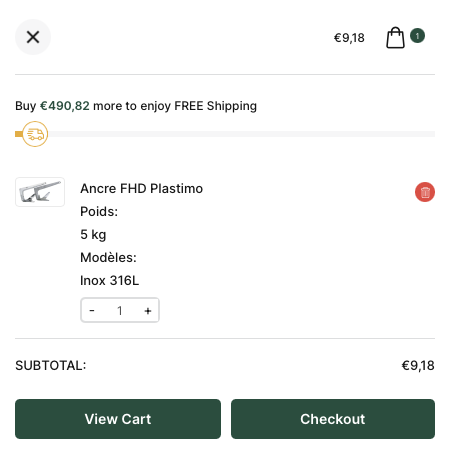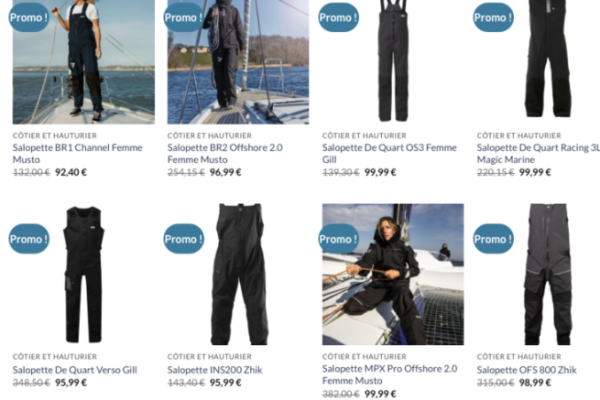Fake online stores have found a new Eldorado in the nautical sector. From discounted HH jackets to "technical" gloves delivered... never, these sites know how to make themselves credible just long enough to collect a payment. And yet, their operation is methodical, almost industrial.
The showcase appears solid: TLS security certificates, Visa and Mastercard icons, return policies copied word for word from those of major brands. Behind the scenes, it's often a single model cloned in a chain: the same site template under dozens of domain names. When one is reported, it immediately disappears and is reborn elsewhere, identical, but with a different domain name.
Behind a fraudulent site lies a well-honed operational chain.
It all starts with the mass creation of domains using automated tools: the scammer launches several hundred names, often on variable-tolerance hosts, and observes which ones attract traffic.
Then comes the fishing for visitors. Scammers sometimes pay for targeted advertising campaigns on Facebook or Instagram, create fake accounts on social networks or send SMS messages containing a "special discount" link.
The most formidable weapon is the deliberately unrealistic price. In the boating sector, some fraudulent websites display products at up to 80% less than the usual authorized dealer price. This level of discount has nothing to do with "destocking": it serves to trigger impulse buying. Con artists know psychology, and are always on the lookout for a bargain. Their aim is not to sell, but to obtain payment as quickly as possible, before mistrust sets in. A price that's too low acts as a hook: it neutralizes critical thinking and encourages people to order without checking the address, the SIRET or the legal notices.
As soon as Internet users enter their bank details, the fraud is activated. In some cases, the card is debited and the funds transferred to mule accounts abroad. In other cases, the payment is simply used to collect bank details, which are then sold on dark web forums.
Finally, once there are too many complaints, the domain is abandoned and replaced by a clone. The whole cycle may take just a few weeks.
The classic scenario is non-delivery: the product simply doesn't exist. Another case is the disguised subscription: the yachtsman thinks he's buying a one-off item, but ends up signing up for a direct debit subscription. Some sites even copy the payment pages of existing stores: this is tunnel phishing. The transaction is merely a pretext for obtaining card numbers. And in the most sophisticated cases, the fraud is twofold: the payment is collected, then the data is resold to other networks.
Case studies: the most common scam schemes
Two sites have recently caught the attention of Internet users: france-discount-Boatsnews.com and marinieremode.com . They display musto jackets at 80% off the oS3 dungarees from Gill at 99 euros the zhik dry suit at 98 euros or the plastimo stainless steel FHD anchor at 9.18 euros . Prices that defy all competition... and, above all, all plausibility.
Public analyses available on the Internet give them a very low confidence score with recently created domains and incomplete or inconsistent legal notices . These elements are among the classic signals of a site at risk: young, poorly referenced and lacking in transparency.

The right reflexes remain the same: check for the presence of a valid company number (SIRET) a landline telephone number and compare prices with those of recognized distributors in the sector. A price difference of over 40 % should immediately arouse suspicion.
For example, the marinieremode .com declares a company "based in Marseille, 56 rue Sainte", but the postal code refers to a Meuse department a revealing geographical gap.
What can a yachting victim do?
When payment has been made by card, the main recourse is chargeback. The customer contests the payment, explaining that he never received the goods.
Banks have a legal time limit, which varies according to the type of card involved, but you need to act quickly, providing all the necessary evidence: screenshots of the order, e-mail exchanges, absence of a tracking number. If the fraud is recognized, the transaction can be cancelled and the funds re-credited.
At the same time, you need to report the site to the authorities: Signal-Conso (DGCCRF) for misleading commercial practices, Signal-Arnaques to centralize testimonials, Pharos, the police platform, in the event of data theft or usurpation. These reports feed into investigations and enable identified sites to be shut down more quickly.

 /
/ 






